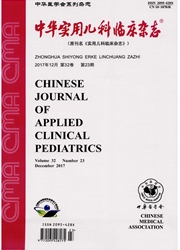

 中文摘要:
中文摘要:
目的观察胎盘早剥新生儿脐血与产妇静脉血血管性血友病因子(VwF)及血管性血友病因子裂解酶(ADAMTS13)水平变化,探讨胎盘早剥新生儿凝血功能异常的病理机制。方法北京军区总医院、北京妇产医院、北京市海淀医院产科2010年11月-2011年11月产科住院病人中,纳入发生胎盘早剥的产妇及新生儿作为胎盘早剥观察组(早剥组);非胎盘早剥观察组(非早剥组)为上述单位早剥组每例患者后2名产科入院患者,以办理入院登记时间为准。采集产妇的静脉血及新生儿脐静脉血、脐动脉血,并收集胎盘组织,用ELISA法检测其VwF、ADAMTS13水平。结果早剥组共纳入58例,非早剥组共纳入116例。根据非早剥组检测值计算出单侧95%参考值。产妇静脉血:VWF〈857.80U·L^-1,ADAMTS13〉119.63U·L^-1;脐静脉血:VwF〈852.71U·L^-1,ADAMTS13〉28.12U·L^-1;脐动脉血:VWF〈1416.96U·L^-1,ADAMTS13〉147.90U·L^-1;胎盘组织VWF〈760.66U·L^-1,ADAMTS13〉27.53U·L^-1早剥组各项VWF高于非早剥组(Pa〈0.05);早剥组产妇血及脐血ADAMTS13水平均低于非早剥组(Pa〈0.05)。结论胎盘早剥孕妇/产妇及胎儿/新生儿体内ADAMTS13水平随VwF水平的升高而下降,VwF足胎盘早剥发生时母儿高凝状态的因素之一,ADAMTS13具有保护作用。
 英文摘要:
英文摘要:
Objective To observe the changes in content of von willebrand factor(VWF) and its catenase( a disintegrin and metalloproteinase with a thrombospondin type 1 motif, member 13, ADAMTS13 ) in the umbilical cord blood and maternal blood after placental abruption happening and to explore the pathophysiological mechanisms of the coagulation abnormalities of placental abruption. Methods The placental abruption group included the cases admitted to the General Hospital of Beijing Military Region, Obstetrics and Gynecology Hospital of Beijing and Haidian Obstetrics and Gynecology Hospital of Beijing from Nov. 2010 to Nov. 2011, and the 2 non - placental abruption inpatients closely next to the certain one of the placental - abrnption group according to the admission time were included as non - placental abruption group for these hospital. Cord blood and maternal blood were collected from each group of newborns during delivering and VWF/ADAMTSI3 were measured by the means of enzyme linked immunosorbent assay. Results Fifty - eight cases were included to the placental abrnption group and 116 cases included to the non - placental abrnption group. The 95% sided reference value were calculated. Maternal blood: VWF 〈 857. 80U·L^-1 ,ADAMTS13 〉 119.63U·L^-1 ;umbilical veins blood:VWF 〈852.71U·L^-1 ,ADAMTS13 〉28.12U·L^-1 ;umbilical arte- rial blood:VWF 〈 1 416.96 U·L^-1, ADAMTSl3 〉 147.90U·L^-1; placental tissue: VWF 〈 760.66U·L^-1,ADAMTS13 〉 27.53U·L^-1 There were discrepancies not only in the maternal blood, umbilical veins blood and umbilical arterial blood of the same group, but each concentration of VWF of the detected subjects in the placental abrnption group was much higher than that of the non - placental abrnption group, while ADAMTS13 concentration of both maternal and umbilical blood of the placental abruption group was lower than that of the non - abruption group ( Pa 〈 0.05 ). Conclusions The concentration of VWF of placental abruption maternal and fetal/neonated body incre
 同期刊论文项目
同期刊论文项目
 同项目期刊论文
同项目期刊论文
 Hsa-miR-134 functions as a regulator of cell proliferation, apoptosis and migration involving of Lun
Hsa-miR-134 functions as a regulator of cell proliferation, apoptosis and migration involving of Lun The Role Of Bone Marrow-Derived Mesenchymal Stem Cells in the Prevention of Hyperoxia-Induced Lung I
The Role Of Bone Marrow-Derived Mesenchymal Stem Cells in the Prevention of Hyperoxia-Induced Lung I MicroRNA Expression Profile in Hyperoxia-exposed Newborn Mice during the Development of Bronchopulmo
MicroRNA Expression Profile in Hyperoxia-exposed Newborn Mice during the Development of Bronchopulmo MiR-134 functions as a regulator of cell proliferation, apoptosis, and migration involving lung sept
MiR-134 functions as a regulator of cell proliferation, apoptosis, and migration involving lung sept 期刊信息
期刊信息
